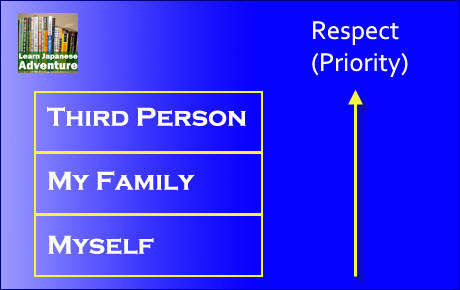- Home
- Intermediate Lessons
- Giving and Receiving of Actions in Japanese Part 1
Giving and Receiving of "Actions" in Japanese
~てあげる ~てもらう ~てくれる Part 1 -
Intermediate Lessons: 37
You have learned the three Japanese verbs for giving and receiving in basic lesson 20:
- あげる (ageru)
- もらう (morau)
- くれる (kureru)
These three verbs can be used further to refer to the giving and receiving of "actions" (deeds).
They indicate who is doing that act for whom, while also expressing a sense of goodwill or gratitude. In this case, the act is expressed by the て-form.
Sentence Patterns
Let's first recall the sentence patterns of あげる (ageru), もらう (morau) and くれる (kureru).
Giver は Receiver に Object を あげる
Receiver は Giver に Object を もらう
Giver は Receiver に Object を くれる
Note: Giver in もらう sentence cannot be the speaker (i.e. 私) himself/herself
As discussed in basic lesson 20, from a Japanese's point of view, he/she always shows the respect to other people (third person) first, followed by his/her own family members (even those who are younger than him/her) and lastly the speaker himself/herself.
The picture below depicts this concept of respect given towards third person, one's family and oneself.

While もらう (morau) sentence focuses on the Receiver (being the subject of the sentence), the focus is on the Giver (subject of the sentence) for both あげる (ageru) and くれる (kureru) sentences.
Also from basic lesson 20, the table below shows whether to use くれる (kureru) or あげる (ageru), depending on whoever is the Giver or Receiver.
When you have to show respect to ONLY the Giver, use くれる (kureru). Otherwise you have to use あげる (ageru).
For example, you use くれる (kureru) when someone (third person) gives something to you or to your family members, OR when your family members gives something to you.
| Giver | Receiver | Use | |
| 1. | Third Person | Third Person | あげる |
| 2. | Third Person | Me/Family Members | くれる |
| 3. | I/Family Members | Third Person | あげる |
| 4. | Family Members | Me | くれる |
| 5. | I | Family Members | あげる |
Giving and Receiving of "Actions" (Deeds)
Understanding the above basic concept of あげる (ageru), もらう (morau) and くれる (kureru), let's move on to learn about the giving and receiving of "actions" (deeds).
In this case, the Giver is doing something (action) for the Receiver instead of only giving something (object).
Let's look at the following sentence:
- 私は家族に写真を見せました。
watashi wa kazoku ni shashin wo misemashita
Meaning: I showed the photos to my family.
The above sentence is just a fact that you've shown the photos to your family. There's no personal feeling contained in the sentence.
If you want to show that your family (Receiver) is grateful for your action, change the sentence by using ~てあげる (~te ageru).
- 私は家族に写真を見せてあげました。
watashi wa kazoku ni shashin wo misete agemashita
Meaning: I showed the photos to my family.
In the above example, the Giver (action taker) is the speaker (私). The receiver is the family (家族) and the family feels grateful for what the speaker has done (showed the photos).
The meaning of the sentence is exactly the same as the previous example except that in this example, the speaker thinks that his/her family will be grateful for his/her action.
Verb て-form あげる
Verb て-form あげる indicates that one does something (by way of doing a favor) for somebody with a sense of goodwill.
When the speaker is the action taker and the listener is the receiver of the act, this expression could give the impression that the speaker's act of doing a favor is forcing an unnecessary help upon the beneficiary.
You are, therefore, advised to avoid using this expression directly to someone whom you do not know very well or who is senior or superior to you.
You may use it on someone with whom you have a very close, friendly relationship.
- 木村さんは田中さんに辞書を貸してあげました。
kimura san wa tanaka san ni jisho wo kashite agemashita
Meaning: Mr Kimura lent Mr Tanaka an dictionary.
The subject of the above example is Mr Kimura, which is also the Giver of the act.
Verb て-form もらう
Verb て-form もらう indicates that "Somebody kindly does something for me" or "I have somebody doing something for me".
This expression conveys a sense of gratitude on the part of those who receive a favor.
- 私は山野さんに日本語を教えてもらいました。
watashi wa yamano san ni nihongo wo oshiete moraimashita
Meaning: Ms Yamano taught me Japanese (and I feel grateful).
The subject of the above example is the speaker (私), which is also the Receiver of the act.
Verb て-form くれる
Verb て-form くれる indicates that somebody does a favor for me. This expression also conveys a sense of gratitude on the part of those who receive a favor.
The difference is that Verb て-form もらう has the Receiver of the act as the subject of the sentence, while Verb て-form くれる has the Giver as the subject of the sentence, implying the giver (the subject) voluntarily takes the action.
The receiver of the act in the latter case is often the speaker and "私 (the receiver) に" is often omitted.
- 山野さんは[私に]日本語を教えてくれました。
yamano san wa [watashi ni] nihongo wo oshiete kuremashita
Meaning: Ms Yamano taught me Japanese (and I feel grateful).
The subject of the above example is Ms Yamano, which is also the Giver of the act. The "私に" in the bracket [] is often omitted.
In the next lesson (part 2 of giving and receiving of "actions"), I will demonstrate how to use ~てあげる, ~てもらう and ~てくれる with many different examples.
You will also learn what are the particles used depending on the verbs in the examples.
Related Page
Basic Lesson 20: Japanese Verbs Give & Receive.
Ready Set Speak Sale! Get up 40% OFF Forever Discount on Premium or Premium PLUS plan! Ends on 19 April 2024
The link above is an affiliate link, which means that I would earn a commission (at no extra cost to you) if you do end up purchasing the related learning course.
Previous - Lesson 36: Japanese Grammar noni のに
Next - Lesson 38: Giving and Receiving of Actions in Japanese Part 2
Buy me a coffee








Facebook Comments
Don’t see the comments box? Log in to your Facebook account, give Facebook consent, then return to this page and refresh it.